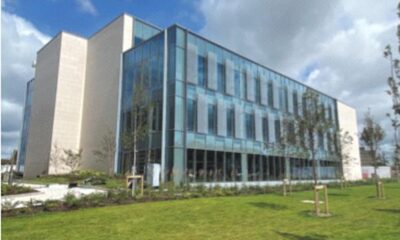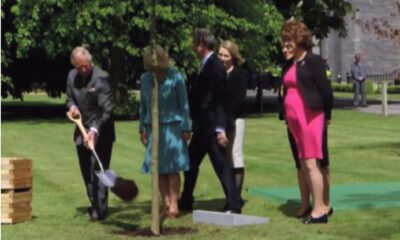CITY TRIBUNE
Galway City status downgraded to ‘moderately littered’ in survey
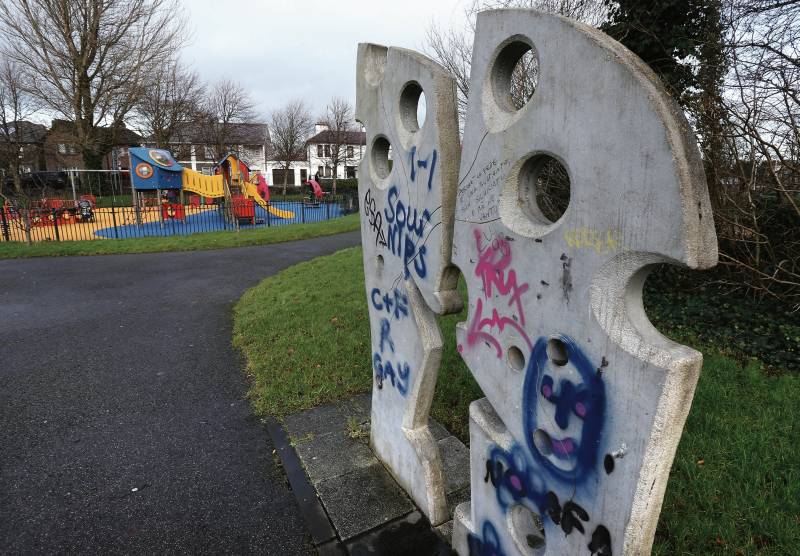
Galway City Tribune – Galway City has lost its status as a ‘clean’ city in a survey of 40 towns and cities across Ireland.
The survey found that the Millennium Children’s Park behind Galway Cathedral was “completely destroyed by graffiti on every available surface”, while the river walk at Canal Road was also found to be heavily littered.
The city has now been branded ‘moderately littered’, along with Tralee, Carlow, Dublin City Centre, Navan and Mahon in Cork City in the latest study carried out by An Taisce on behalf of IBAL (Irish Business Against Litter) – it had only regained its litter-free status last September.
Ballybane – which was classed as a town for the purposes of the survey – was branded as ‘littered’ and came in at Number 38 in the league table. The Fana Glas estate was found to have “persistent litter”, while one side of St Brigid’s Church was subject to dumping.
The report found that Galway is lagging behind most other cities, having improved just three months earlier.
“It is disappointing to see this important tourist destination again slip to moderately littered having improved earlier in the year – it is lagging behind most other cities. The Courthouse and environs and Town Hall Theatre and environs were both much improved but still somewhat littered.
“The Millennium Children’s Playground was completely destroyed by graffiti on every available surface, including a piece of sculpture,” the report reads.
What the judges said:
N17 Approach: Grade B. This was generally a clean and welcoming approach to Galway City with built-up industrial and commercial estates on both sides of the road. It was somewhat littered closer to the city and this took away from an otherwise well-presented environment.
Bóthar na dTreabh: Grade A. (From Tuam Road junction to Kirwan roundabout). All appeared in good order along this route. The planting was an attractive feature and the overall impression was of a clean and tidy environment.
University Hospital Galway: Grade A. The grounds of the hospital were in very good order – e.g. signage, planting, bins, low-lying shrubbery. The overall impression created here was a very positive one.
Carpark at UHG: Grade A. Overall, the carpark was presented well. The surface was in good condition and there was a virtual absence of litter.
NUIG: Grade A. The campus was in excellent order. Not only was there a complete absence of litter throughout the extensive area surveyed, but the whole area was exceptionally well-presented and maintained. The mature grounds and buildings were in very good order. The litter bins were designed so that one side was for ‘general waste’ and the other was for recycling plastics, paper, cardboard and tin cans.
NUIG O’Donoghue Centre and Bridge: Grade A. The general environs of the building, including the bridge were in very good order, with a virtual absence of litter.
Eglinton Canal Walk: Grade C. This waterside environment was very much let down by heavy levels of alcohol-related litter. There was plenty of broken glass underfoot and cans had been stuck into the wall. Graffiti was also a feature at this site.
Millennium Children’s Park: Grade C. This city centre park has been destroyed by graffiti on every conceivable surface e.g. signage at entrance, Council visitor information notice board (which was devoid of any notices), litter bin, public toilets, skateboard park and even on the sculpture. There were some sweet papers. The grass/planted areas were in very good condition.
Galway Cathedral: Grade A. The Cathedral and area immediately surrounding it were spotless. The railings, paving, raised planted area, ramp signage etc. were all in excellent order. The carpark was in very good order, creating a positive impression throughout. It was clean, tidy and completely free of litter.
Courthouse: Grade B. There was a marked improvement and this time around it just missed getting the top litter grade. Some food related litter (fast-food wrappers, sweet papers, coffee cups and cans) and occasional cigarette-related litter took away from an otherwise very nicely presented environment – the building, paving, ornamental trees, railings etc. were all in excellent order.
Town Hall Theatre: Grade B. With a little extra care and attention this site could easily get the top litter grade. Cigarette-related litter was pronounced, along with plastic bottles and plastic bags. The overall impression was quite a good one in terms of presentation.
St Nicholas Parochial School: Grade A. This school had the appearance of a lovingly-tended environment. Seats were brightly painted, spiral staircase was adorned with colourful bunting and hand and footprints decorated another wall surface. Overall, it was a top-ranking site with a complete absence of litter throughout.
Waterside/Rowing Club: Grade C. The riverwalk along the banks adjacent to the club mooring was well cared for and almost entirely free of litter. However, there was a wide variety of litter in the water at a corner area – this area of water had limited flow, resulting in ‘trapped’ litter and scum/slime on the water’s surface.
Waterside (Woodquay): Grade A. The overall impression at this city centre residential area was a good one with well-tended gardens and a virtual absence of litter. There was a derelict site with overgrown weeds, but no major litter accumulations.
Waterside park: Grade A. A small city centre park with mature trees and well-maintained grass. It was pretty clean with regard to litter but three benches within the park were completely broken.
Dyke Road Carpark: Grade C. The main surface area of the car park was in very good condition and clear of litter. It was the perimeter area, which was heavily-weeded and had trapped litter which brought down the litter grade. The majority of the litter was food-related. Signage relating to car park was in very good condition.
Recycle bank at Dyke Road: Grade B. The bins were mostly quite clean and presented well. It was the broken glass along the base of the bins and bottle tops/lids in the low-lying shrubbery which brought down the overall litter grade.
IMC Cinema: Grade B. The IMC building and environs were beginning to look tired with an unsightly black mould/fungus on one wall of the building. Much of the red paint on the railing had worn away and the black litter bin was very grubby. Chewing gum was pronounced, with lower levels of sweet papers and cigarette butts.
Galway Retail Park: Grade A. The colourful planting in this retail park was welcome in such a built-up environment. Many of the ‘older’ style of litter bins were in very poor condition, grubby and with the notices worn away. The newer bins were generally much fresher in appearance. Signage, paving, planted areas and general environment were in good order.
St. Brendan’s Avenue: Grade A. This street with a mix of terraced houses and apartments was generally in good order. The pavement on one side was subsiding. The road surface and markings and signage were in good order.
Eyre Square: Grade B. With a little extra care and attention this significant city centre site could easily get the top litter grade. The litter was most pronounced at the steps. It was very well-presented and maintained.
Abbeygate Street, Lower: Grade A. This pedestrianised city centre shopping street presented very well with attractive paving and shop fronts.
Meanwhile, Ballybane had a very disappointing result in the survey, coming 38th out of 40 towns and cities (for the purposes of the survey, it was classed as a town).
Ballybane had two blackspots, after a great showing early in 2017.
The survey stated that most of its moderately littered sites could easily get the top litter grade with a little extra care and attention. These included areas such as East United Football Club, Ballybane Road, GMIT and Ballybane Shopping Centre.
However, the Fána Glas housing estate was a blackspot, as was the area around St Brigid’s Church.
East United Football Club earned a Grade B and just missed the top grade. The club building, forecourt and enclosed play area were excellent. Food-related litter and plywood sheeting took away from an otherwise very well-maintained environment.
Glenavon Drive, a residential area consisting of six semi-detached houses, received a Grade A. It was in very good order with a virtual absence of litter.
Castlepark, Numbers 1-16 and 278-339, received a Grade C. The estate was mixed with regard to litter, according to the survey. Houses 1-16 were almost litter free. The higher house numbers in one were in much better condition, while the mid- to lower-house numbers had considerable litter.
St Brigid’s Church was deemed Grade D. It was mostly clean and well-maintained. However, bags of rubbish were strewn about an area which is highly visible to anybody using the car-park.
Fána Glas also received a Grade D. Horse dung, old clothes, plastic wrapping and carpets were present, as was graffiti. Some houses were well cared for but many were not. A boarded-up house had site-security notices.

Illegal dumping in Fana Glas.
Rocklands Avenue, a moderately littered residential area which had food-related litter and plastic wrapping, got a Grade B.
Ballybane Shopping Centre got a Grade B, and the survey stated that with a little extra attention it could get the top grade. Chewing gum was an issue, as were graffiti and moss and grubby litter bins. The high number of closed and vacant outlets create a ‘shuttered’ environment.
The recycle facility at Ballybane Shopping Centre was in excellent order and got an A grade for clean bins and a total absence of litter.
Ballybane Road got Grade B. One area near the shopping centre was littered with coffee cups, plastic bottles, fast-food wrappers and sweet papers.
GMIT also got Grade B. Its overall presentation was excellent, but some food-related litter was found in the shrubbery at the road front – otherwise, it would have been a top site.
CITY TRIBUNE
Galway ‘masterplan’ needed to tackle housing and transport crises
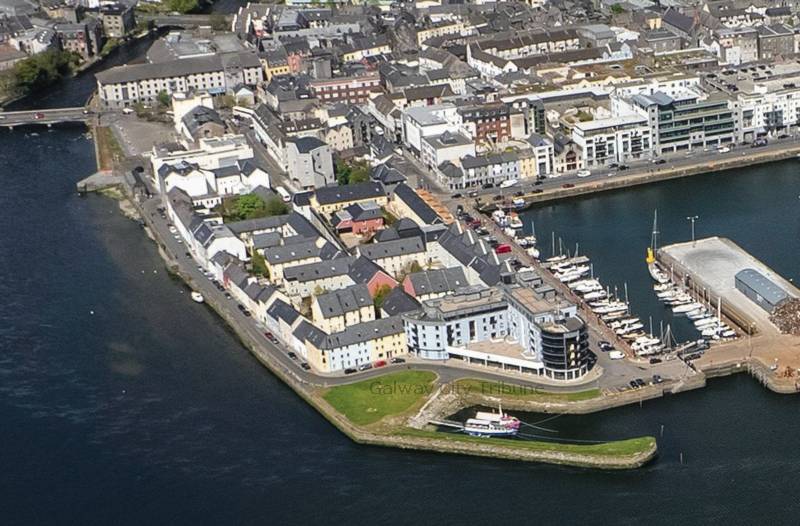
From the Galway City Tribune – An impassioned plea for a ‘masterplan’ that would guide Galway City into the future has been made in the Dáil. Galway West TD Catherine Connolly stated this week that there needed to be an all-inclusive approach with “vision and leadership” in order to build a sustainable city.
Deputy Connolly spoke at length at the crisis surrounding traffic and housing in Galway city and said that not all of the blame could be laid at the door of the local authority.
She said that her preference would be the provision of light rail as the main form of public transport, but that this would have to be driven by the government.
“I sat on the local council for 17 years and despaired at all of the solutions going down one road, metaphorically and literally. In 2005 we put Park & Ride into the development plan, but that has not been rolled out. A 2016 transport strategy was outdated at the time and still has not been updated.
“Due to the housing crisis in the city, a task force was set up in 2019. Not a single report or analysis has been published on the cause of the crisis,” added Deputy Connolly.
She then referred to a report from the Land Development Agency (LDA) that identified lands suitable for the provision of housing. But she said that two-thirds of these had significant problems and a large portion was in Merlin Park University Hospital which, she said, would never have housing built on it.
In response, Minister Simon Harris spoke of the continuing job investment in the city and also in higher education, which is his portfolio.
But turning his attention to traffic congestion, he accepted that there were “real issues” when it came to transport, mobility and accessibility around Galway.
“We share the view that we need a Park & Ride facility and I understand there are also Bus Connects plans.
“I also suggest that the City Council reflect on her comments. I am proud to be in a Government that is providing unparalleled levels of investment to local authorities and unparalleled opportunities for local authorities to draw down,” he said.
Then Minister Harris referred to the controversial Galway City Outer Ring Road which he said was “struck down by An Bord Pleanála”, despite a lot of energy having been put into that project.
However, Deputy Connolly picked up on this and pointed out that An Bord Pleanála did not say ‘No’ to the ring road.
“The High Court said ‘No’ to the ring road because An Bord Pleanála acknowledged it failed utterly to consider climate change and our climate change obligations.
“That tells us something about An Bord Pleanála and the management that submitted such a plan.”
In the end, Minister Harris agreed that there needed to be a masterplan for Galway City.
“I suggest it is for the local authority to come up with a vision and then work with the Government to try to fund and implement that.”
CITY TRIBUNE
Official opening of Galway’s new pedestrian and cycle bridge
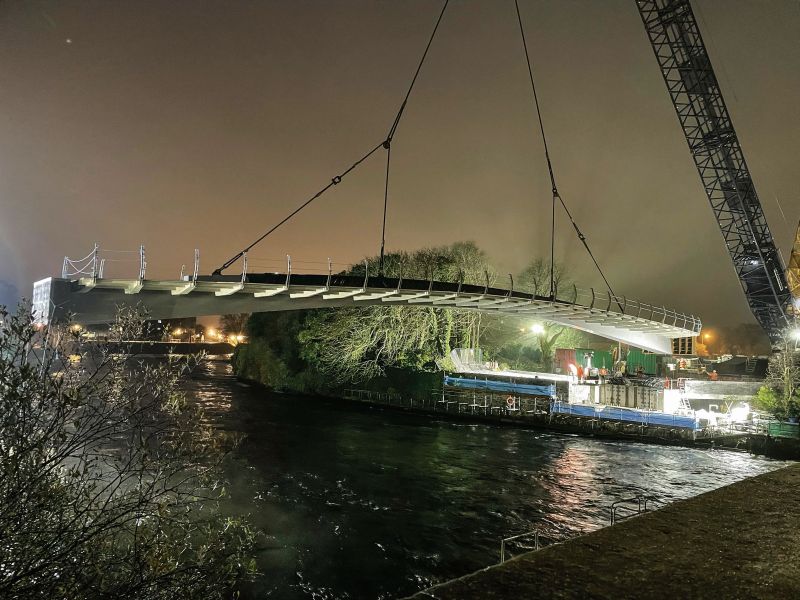
The new Salmon Weir pedestrian and cycle bridge will be officially opened to the public next Friday, May 26.
Work on the €10 million bridge got underway in April 2022, before the main structure was hoisted into place in early December.
A lunchtime tape-cutting ceremony will take place on Friday, as the first pedestrians and cyclists traverse the as-yet-unnamed bridge.
The Chief Executive of Galway City Council, Brendan McGrath, previously said the bridge, once opened, would remove existing conflicts between pedestrians, cyclists and traffic “as well as facilitating the Cross-City Link public transport corridor over the existing 200-year-old bridge”.
The naming of the new bridge has been under discussion by the Council’s Civic Commemorations Committee since late last year.
One name that has been in the mix for some time is that of the first woman in Europe to graduate with an engineering degree – Alice Perry.
Ms Perry, who was from Wellpark, graduated from Queen’s College Galway (now University of Galway) in 1906. The university’s engineering building is named in her honour.
The bridge was built by Jons Civil Engineering firm in County Meath and was assembled off-site before being transported to Galway. Funding for the project was provided in full by the National Transport Authority and the European Regional Development Fund.
(Photo: Sheila Gallagher captured the city’s new pedestrian footbridge being raised on the south side of the Salmon Weir Bridge in December. It will officially open next Friday, May 26).
CITY TRIBUNE
Minister branded ‘a disgrace’ for reversing land rezoning in Galway City

From the Galway City Tribune – Minister of State for Local Government and Planning, Kieran O’Donnell was labelled a “disgrace” for overturning councillors’ decisions to rezone land in the new City Development Plan.
Minister O’Donnell (pictured) confirmed in a letter to Council Chief Executive Brendan McGrath last week that he was reversing 25 material alternations made by councillors to the CDP 2023-29. He made the decision on the advice of Office of Planning Regulator (OPR).
Minister O’Donnell directed that 14 land parcels that were subject to land-use zoning changes by councillors as part of the Material Alterations to the Draft CDP should be reversed.
He directed that a further 11 land parcels in the city should become “unzoned”.
The Minister found that the CDP had not been made in a manner consistent with recommendations of the OPR, which required specific changes to the plan to ensure consistency with the national planning laws and guidelines.
At last week’s Council meeting Cllr Eddie Hoare (FG) asked for clarity on the process by which councillors could rezone the lands that had been changed by the Minister’s direction.
Cllr Declan McDonnell said, “What he [Minister O’Donnell] has done is an absolute disgrace”.
And he asked: “Do we have to have another development plan meeting to deal with it?”
Both Cllrs Hoare and McDonnell wondered what would become of the lands that were rezoned or unzoned by the ministerial direction.
Mr McGrath said the Council had put forward an argument in favour of retaining the material alterations in the plan, but ultimately the Minister sided with OPR.
He said if councillors want to make alterations to the new plan, they could go through the process of making a material alteration but this was lengthy.
The Save Roscam Peninsula campaign welcomed the Minister’s decision.
In a statement to the Galway City Tribune, it said the direction would mean the Roscam village area on the Roscam Peninsula will be unzoned and a number of land parcels would revert back to agriculture/high amenity.
A spokesperson for the campaign said: “the material alterations made by city councillors following lobbying by developers continued the long-standing practice of councillors facilitating a developer-led plan rather than an evidence- and policy-based plan that meets the needs of the city.
“The Minister’s direction is an important step in restoring confidence in the planning system. It is clear from the City Council’s own evidence on future housing projections that there was no requirement to zone these lands for residential purposes in order to meet the needs of the targeted population increase up to 2029,” the spokesperson added.


